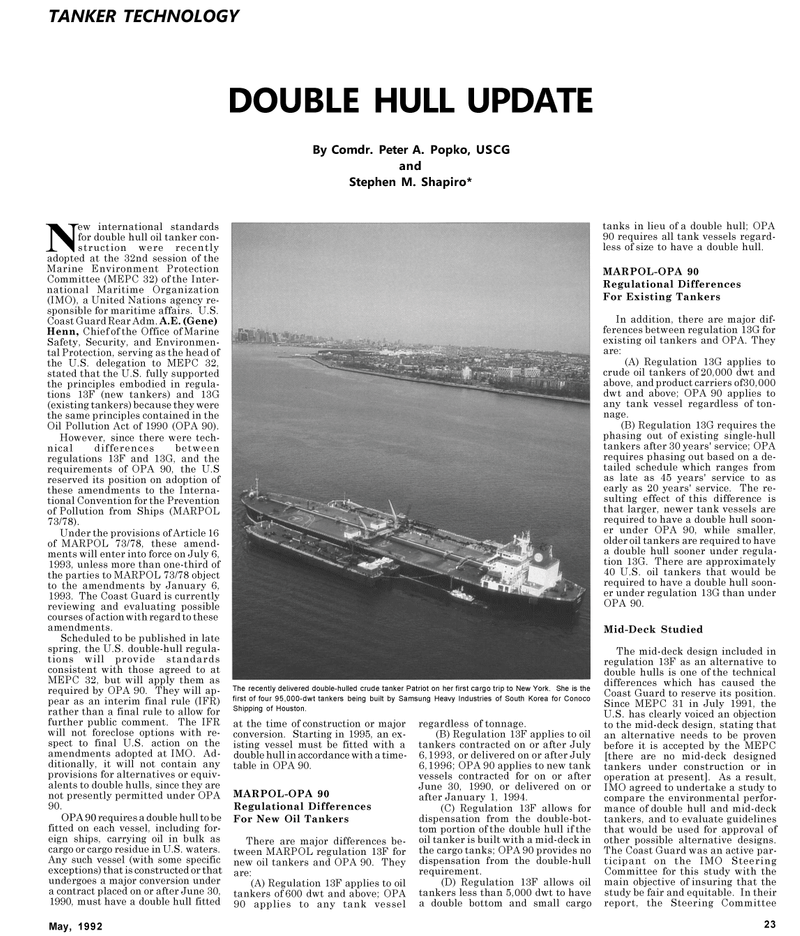
Page 23: of Maritime Reporter Magazine (May 1992)
Read this page in Pdf, Flash or Html5 edition of May 1992 Maritime Reporter Magazine
TANKER TECHNOLOGY
DOUBLE HULL UPDATE
By Comdr. Peter A. Popko, USCG and
Stephen M. Shapiro*
The recently delivered double-hulled crude tanker Patriot on her first cargo trip to New York. She is the first of four 95,000-dwt tankers being built by Samsung Heavy Industries of South Korea for Conoco
Shipping of Houston.
New international standards for double hull oil tanker con-struction were recently adopted at the 32nd session of the
Marine Environment Protection
Committee (MEPC 32) of the Inter- national Maritime Organization (IMO), a United Nations agency re- sponsible for maritime affairs. U.S.
Coast Guard Rear Adm. A.E. (Gene)
Henn, Chief of the Office of Marine
Safety, Security, and Environmen- tal Protection, serving as the head of the U.S. delegation to MEPC 32, stated that the U.S. fully supported the principles embodied in regula- tions 13F (new tankers) and 13G (existing tankers) because they were the same principles contained in the
Oil Pollution Act of 1990 (OPA 90).
However, since there were tech- nical differences between regulations 13F and 13G, and the requirements of OPA 90, the U.S reserved its position on adoption of these amendments to the Interna- tional Convention for the Prevention of Pollution from Ships (MARPOL 73/78).
Under the provisions of Article 16 of MARPOL 73/78, these amend- ments will enter into force on July 6, 1993, unless more than one-third of the parties to MARPOL 73/78 object to the amendments by January 6, 1993. The Coast Guard is currently reviewing and evaluating possible courses of action with regard to these amendments.
Scheduled to be published in late spring, the U.S. double-hull regula- tions will provide standards consistent with those agreed to at
MEPC 32, but will apply them as required by OPA 90. They will ap- pear as an interim final rule (IFR) rather than a final rule to allow for further public comment. The IFR will not foreclose options with re- spect to final U.S. action on the amendments adopted at IMO. Ad- ditionally, it will not contain any provisions for alternatives or equiv- alents to double hulls, since they are not presently permitted under OPA 90.
OPA 90 requires a double hull to be fitted on each vessel, including for- eign ships, carrying oil in bulk as cargo or cargo residue in U.S. waters.
Any such vessel (with some specific exceptions) that is constructed or that undergoes a major conversion under a contract placed on or after June 30, 1990, must have a double hull fitted at the time of construction or major conversion. Starting in 1995, an ex- isting vessel must be fitted with a double hull in accordance with a time- table in OPA 90.
MARPOL-OPA 90
Regulational Differences
For New Oil Tankers
There are major differences be- tween MARPOL regulation 13F for new oil tankers and OPA 90. They are: (A) Regulation 13F applies to oil tankers of 600 dwt and above; OPA 90 applies to any tank vessel regardless of tonnage. (B) Regulation 13F applies to oil tankers contracted on or after July 6,1993, or delivered on or after July 6,1996; OPA 90 applies to new tank vessels contracted for on or after
June 30, 1990, or delivered on or after January 1, 1994. (C) Regulation 13F allows for dispensation from the double-bot- tom portion of the double hull if the oil tanker is built with a mid-deck in the cargo tanks; OPA 90 provides no dispensation from the double-hull requirement. (D) Regulation 13F allows oil tankers less than 5,000 dwt to have a double bottom and small cargo tanks in lieu of a double hull; OPA 90 requires all tank vessels regard- less of size to have a double hull.
MARPOL-OPA 90
Regulational Differences
For Existing Tankers
In addition, there are major dif- ferences between regulation 13G for existing oil tankers and OPA. They are: (A) Regulation 13G applies to crude oil tankers of 20,000 dwt and above, and product carriers of30,000 dwt and above; OPA 90 applies to any tank vessel regardless of ton- nage. (B) Regulation 13G requires the phasing out of existing single-hull tankers after 30 years' service; OPA requires phasing out based on a de- tailed schedule which ranges from as late as 45 years' service to as early as 20 years' service. The re- sulting effect of this difference is that larger, newer tank vessels are required to have a double hull soon- er under OPA 90, while smaller, older oil tankers are required to have a double hull sooner under regula- tion 13G. There are approximately 40 U.S. oil tankers that would be required to have a double hull soon- er under regulation 13G than under
OPA 90.
Mid-Deck Studied
The mid-deck design included in regulation 13F as an alternative to double hulls is one of the technical differences which has caused the
Coast Guard to reserve its position.
Since MEPC 31 in July 1991, the
U.S. has clearly voiced an objection to the mid-deck design, stating that an alternative needs to be proven before it is accepted by the MEPC [there are no mid-deck designed tankers under construction or in operation at present]. As a result,
IMO agreed to undertake a study to compare the environmental perfor- mance of double hull and mid-deck tankers, and to evaluate guidelines that would be used for approval of other possible alternative designs.
The Coast Guard was an active par- ticipant on the IMO Steering
Committee for this study with the main objective of insuring that the study be fair and equitable. In their report, the Steering Committee
May, 1992 23

 22
22

 24
24
